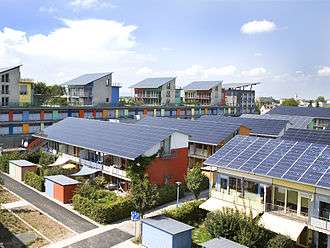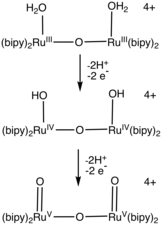Water oxidation catalysis
Water oxidation catalysis (WOC) is the acceleration (catalysis) of the conversion of water into oxygen and protons:
- 2 H2O → 4 H+ + 4 e− + O2

Many catalysts are effective, both homogeneous catalysts and heterogeneous catalysts. The oxygen evolving complex in photosynthesis is the premier example. There is no interest in generating oxygen by water oxidation since oxygen is readily obtained from air. Instead, interest in water oxidation is motivated by its relevance to water splitting, which would provide "solar hydrogen," i.e. water oxidation would generate the electrons and protons for the production of hydrogen.[2] An ideal WOC would operate rapidly at low overpotential, exhibit high stability and be of low cost, derived from nontoxic components.
Mechanistic and energetic principles
Water is more difficult to oxidize than its conjugate base hydroxide. Hydroxide is stabilized by coordination to metal cations. Some metal hydroxides, those featuring redox-active metal centers, can be oxidized to give metal oxo complexes. Attack of water on metal oxo centers represents one pathway for the formation of the O-O bond, leading to dioxygen. Alternatively, the crucial O-O bond forming step can arise by coupling suitably positioned pairs of metal hydroxo centers. The molecular mechanism of the OEC has not been elucidated.
The conversion of even metal hydroxo complexes to O2 requires very strong oxidants. In photosynthesis, such oxidants are provided by electron holes on porphyrin radical cations. For device applications, the aspirational oxidant is a photovoltaic material. For screening WOCs, ceric ammonium nitrate is a typical electron acceptor.

Homogeneous catalysis
Ruthenium complexes
A number of ruthenium-aqua complexes catalyze the oxidation of water. Most catalysts feature bipyridine and terpyridine ligands.[3][4][2] Catalysts containing pyridine-2-carboxylate exhibit rates (300 s−1) comparable to that of photosystem II.[5][6] Work in this area has ushered in many new polypyridyl ligands.[7][8]

Cobalt and iron complexes
Early examples of cobalt-based WOCs suffered from instability.[9] A homogeneous WOC [Co(Py5)(H2O)](ClO4)2[10] operates by a proton-coupled electron transfer to form a [CoIII--OH]2+ species, which on further oxidation forms a CoIV intermediate. The intermediate formed reacts with water to liberate O2. The cobalt-polyoxometalate complex [Co4(H2O)2(α-PW9O34)2]10− is highly efficient WOC.[11]
Some iron complexes catalyze water oxidation. A water-soluble complex [Fe(OTf)2(Me2Pytacn)] (Pytacn=pyridine-substituted trimethyltriazacyclononane; OTf= triflate) is an efficient WOC. The concentration of the catalyst and the oxidant were found to be strongly affecting the oxidation process. Many related complexes with cis labile sites are active catalysts. Most complexes were found to undergo degradation in a few hours. Higher stability of the molecular catalyst may be achieved using robust clathrochelate ligands that stabilize high oxidation states of iron and prevent rapid degradation of the catalyst.[12] The number and stereochemistry of reactive coordination sites on Fe have been evaluated but few guidelines have emerged.[13]
Iridium complexes
The complexes [Ir(ppy)2(OH2)2]+ (ppy = 2-phenylpyridine) exhibit high turnover numbers, but low catalytic rates. Replacing ppy with Cp* (C5Me5) results in increased catalytic activity but decreased the turnover number.[14] Water nucleophilic attack on Ir=O species was found to be responsible for the O2 formation.[15]
Heterogeneous catalysis
Iridium oxide is a stable bulk WOC catalyst with low overpotential.[16]
Ni-based oxide film liberates oxygen in quasi-neutral conditions at an overpotential of ~425 mV and shows long lasting stability.[17] X-ray spectroscopy revealed the presence of di-µ-oxide bridging between NiIII/NiIV ions but no evidence of mono-µ-oxide bridging was found between the ions.[18] Similar structures can be found in Co-WOC films and Mn-WOC catalysts.[19][20]
Cobalt oxides (Co3O4) have been investigated to work on the same pattern as other cobalt salts.[21] Cobalt phosphates are also active WOCs at neutral pH.[22] Stable and highly active WOCs can be prepared by adsorbing CoII on silica nanoparticles.[23]
Additional reviews
- Meyer, T. J., Chemical approaches to artificial photosynthesis. Accounts of Chemical Research 1989, 22, 163–170.
- Balzani, V.; Credi, A.; Venturi, M., Photochemical Conversion of Solar Energy. ChemSusChem 2008, 1, 26–58.
- Sala, X.; Romero, I.; Rodríguez, M.; Escriche, L.; Llobet, A., Molecular Catalysts that Oxidize Water to Dioxygen. Angewandte Chemie International Edition 2009, 48, 2842–2852.
- Gratzel, M., Photoelectrochemical cells. Nature 2001, 414, 338–344.
- Eisenberg, R.; Gray, H. B., Preface on Making Oxygen. Inorganic Chemistry 2008, 47, 1697–1699.
- Sun, L.; Hammarstrom, L.; Akermark, B.; Styring, S., Towards artificial photosynthesis: ruthenium-manganese chemistry for energy production. Chemical Society Reviews 2001, 30, 36–49.
- Gust, D.; Moore, T. A.; Moore, A. L., Solar Fuels via Artificial Photosynthesis. Accounts of Chemical Research 2009, 42, 1890–1898.
References
- Umena, Yasufumi; Kawakami, Keisuke; Shen, Jian-Ren; Kamiya, Nobuo (May 2011). "Crystal structure of oxygen-evolving photosystem II at a resolution of 1.9 Å" (PDF). Nature. 473 (7345): 55–60. Bibcode:2011Natur.473...55U. doi:10.1038/nature09913. PMID 21499260.
- Liu, F.; Concepcion, J. J.; Jurss, J. W.; Cardolaccia, T.; Templeton, J. L.; Meyer, T. J. (2008). "Mechanisms of Water Oxidation from the Blue Dimer to Photosystem II". Inorganic Chemistry. 47 (6): 1727–1752. doi:10.1021/ic701249s. PMID 18330966.CS1 maint: uses authors parameter (link)
- Wada, T.; Tsuge, K.; Tanaka, K. (2000). "Electrochemical Oxidation of Water to Dioxygen Catalyzed by the Oxidized Form of the Bis(ruthenium – hydroxo) Complex in H2O". Angewandte Chemie International Edition. 39 (8): 1479–1482. doi:10.1002/(SICI)1521-3773(20000417)39:8<1479::AID-ANIE1479>3.0.CO;2-4.CS1 maint: multiple names: authors list (link)
- Sens, C.; Romero, I.; Rodríguez, M.; Llobet, A.; Parella, T.; Benet-Buchholz, J. (2004). "A New Ru Complex Capable of Catalytically Oxidizing Water to Molecular Dioxygen". Journal of the American Chemical Society. 126 (25): 7798–7799. doi:10.1021/ja0486824. PMID 15212526.CS1 maint: multiple names: authors list (link)
- Duan, L.; Fischer, A.; Xu, Y.; Sun, L. (2009). "Isolated Seven-Coordinate Ru(IV) Dimer Complex with [HOHOH]− Bridging Ligand as an Intermediate for Catalytic Water Oxidation". Journal of the American Chemical Society. 131 (30): 10397–10399. doi:10.1021/ja9034686. PMID 19601625.CS1 maint: multiple names: authors list (link)
- Duan, L.; Bozoglian, F.; Mandal, S.; Stewart, B.; Privalov, T.; Llobet, A.; Sun, L. (2012). "A molecular ruthenium catalyst with water-oxidation activity comparable to that of photosystem II". Nat. Chem. 4 (5): 418–423. Bibcode:2012NatCh...4..418D. doi:10.1038/nchem.1301. PMID 22522263.CS1 maint: uses authors parameter (link)
- Zong, R.; Thummel, R. P. (2005). "A New Family of Ru Complexes for Water Oxidation". Journal of the American Chemical Society. 127 (37): 12802–12803. doi:10.1021/ja054791m. PMID 16159265.CS1 maint: multiple names: authors list (link)
- Zhang, G.; Zong, R.; Tseng, H.-W.; Thummel, R. P. (2008). "Ru(II) Complexes of Tetradentate Ligands Related to 2,9-Di(pyrid-2'-yl)-1,10-phenanthroline". Inorganic Chemistry. 47 (3): 990–998. doi:10.1021/ic701798v. PMID 18183971.CS1 maint: multiple names: authors list (link).
- Brunschwig, B. S.; Chou, M. H.; Creutz, C.; Ghosh, P.; Sutin, N., Mechanisms of water oxidation to oxygen: cobalt(IV) as an intermediate in the aquocobalt(II)-catalyzed reaction. Journal of the American Chemical Society 1983, 105, 4832-4833.
- Wasylenko, D. J.; Ganesamoorthy, C.; Borau-Garcia, J.; Berlinguette, C. P., Electrochemical evidence for catalytic water oxidation mediated by a high-valent cobalt complex. Chemical communications 2011, 47, 4249-4251.
- Yin, Q.; Tan, J. M.; Besson, C.; Geletii, Y. V.; Musaev, D. G.; Kuznetsov, A. E.; Luo, Z.; Hardcastle, K. I.; Hill, C. L., A fast soluble carbon-free molecular water oxidation catalyst based on abundant metals. Science 2010, 328, 342-345.
- Fritsky, Igor O.; Berggren, Gustav; Sá, Jacinto; Mamedov, Fikret; D’Amario, Luca; Pavliuk, Mariia V.; Shylin, Sergii I. (2019-02-18). "Efficient visible light-driven water oxidation catalysed by an iron(IV) clathrochelate complex". Chemical Communications. 55 (23): 3335–3338. doi:10.1039/C9CC00229D. ISSN 1364-548X. PMID 30801592.
- Fillol, J. L.; Codolà, Z.; Garcia-Bosch, I.; Gómez, L.; Pla, J. J.; Costas, M., Efficient water oxidation catalysts based on readily available iron coordination complexes. Nat Chem 2011, 3, 807-813.
- Hull, J. F.; Balcells, D.; Blakemore, J. D.; Incarvito, C. D.; Eisenstein, O.; Brudvig, G. W.; Crabtree, R. H. (2009). "Highly Active and Robust Cp* Iridium Complexes for Catalytic Water Oxidation". Journal of the American Chemical Society. 131 (25): 8730–8731. doi:10.1021/ja901270f. PMC 2742501. PMID 19496565.CS1 maint: uses authors parameter (link)
- Blakemore, J. D.; Schley, N. D.; Balcells, D.; Hull, J. F.; Olack, G. W.; Incarvito, C. D.; Eisenstein, O.; Brudvig, G. W.; Crabtree, R. H. (2010). "Half-Sandwich Iridium Complexes for Homogeneous Water-Oxidation Catalysis". Journal of the American Chemical Society. 132 (45): 16017–16029. doi:10.1021/ja104775j. PMID 20964386.CS1 maint: uses authors parameter (link)
- Youngblood, W. J.; Lee, S.-H. A.; Maeda, K.; Mallouk, T. E. (2009). "Visible Light Water Splitting Using Dye-Sensitized Oxide Semiconductors". Accounts of Chemical Research. 42 (12): 1966–1973. doi:10.1021/ar9002398. PMID 19905000.CS1 maint: uses authors parameter (link)
- Dincă, M.; Surendranath, Y.; Nocera, D. G., Nickel-borate oxygen-evolving catalyst that functions under benign conditions. Proceedings of the National Academy of Sciences 2010, 107, 10337-10341.
- Risch, M.; Klingan, K.; Heidkamp, J.; Ehrenberg, D.; Chernev, P.; Zaharieva, I.; Dau, H., Nickel-oxido structure of a water-oxidizing catalyst film. Chemical communications 2011, 47, 11912-11914.
- Zaharieva, I.; Najafpour, M. M.; Wiechen, M.; Haumann, M.; Kurz, P.; Dau, H., Synthetic manganese–calcium oxides mimic the water-oxidizing complex of photosynthesis functionally and structurally. Energy & Environmental Science 2011, 4, 2400-2408.
- Kanan, M. W.; Yano, J.; Surendranath, Y.; Dincă, M.; Yachandra, V. K.; Nocera, D. G., Structure and Valency of a Cobalt−Phosphate Water Oxidation Catalyst Determined by in Situ X-ray Spectroscopy. Journal of the American Chemical Society 2010, 132, 13692-13701.
- Harriman, A.; Pickering, I. J.; Thomas, J. M.; Christensen, P. A., Metal oxides as heterogeneous catalysts for oxygen evolution under photochemical conditions. Journal of the Chemical Society, Faraday Transactions 1: Physical Chemistry in Condensed Phases 1988, 84, 2795-2806.
- Matthew W. Kanan, Yogesh Surendranatha, Daniel G. Nocera (2009). "Cobalt–phosphate oxygen-evolving Compound". Chem. Soc. Rev. 38 (1): 109–114. doi:10.1039/B802885K. PMID 19088970.CS1 maint: uses authors parameter (link)
- Zidki, T.; Zhang, L.; Shafirovich, V.; Lymar, S. V. (2012). "Water Oxidation Catalyzed by Cobalt(II) Adsorbed on Silica Nanoparticles". Journal of the American Chemical Society. 134 (35): 14275–14278. doi:10.1021/ja304030y. PMID 22913479.CS1 maint: uses authors parameter (link)